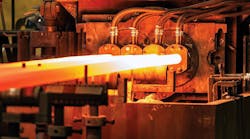A research project underway now proposes to digitize the process of casting iron. “What exactly happens when the molten iron is let out of the furnaces and into the mold has until now been a great mystery to the entire foundry industry; you could almost call it a kind of black box,” explained researcher Ashish Chawla. “This has made it extremely difficult to digitize and thus automate the cast iron production.”
According to Chawla’s plan of developing models and applying artificial intelligence, the Tasso A/S foundry in Odense, Denmark, will gain better control of its manufacturing processes, streamlining workflows, increasing productivity, and reducing energy consumption, according to the foundry.
Chawla recently published a paper on the first part of his three-stage research project, which is the basis for his PhD project at the Technical University of Denmark.
Tasso is one of six businesses that form the BIRN Group of ferrous foundries, but its particular specialty is continuous cast iron bars, including heat-treatment and surface machining, according to customers’ needs. As the researcher noted, this is essentially a high-volume (18,000 metric tons/year), permanent molding process in which molten metal is solidified into semi-finished shapes (billets.)
While Chawla’s research began in 2020, it is in line with a digitization initiative that Tasso began in 2014, focusing on predictive maintenance and analytics-based planning, to improve its workflow. The current objective is to optimize horizontal continuous casting by mapping the relationship between operating input process parameters (e.g., melt velocity, inlet melt temperature, and water flowrate to the solidification of outside shell.) From this, Chawla established a precise model of top-air gap formations, including the effect of those gaps’ length and thickness on the solid, austenitic, and eutectic shell thickness.
A three-dimensional, steady-state numerical model of cast iron solidification that Chawla defined takes into account coupled fluid flow and heat transfer. The phase change of the iron alloy is integrated into the model through heat release over specific temperature spans. Simulations are validated against experimental data from an industrial casting line, and the numerical model is applied to study the relationship between the melt-mold air gaps and the shell thickness.
The model made it possible to identify optimal locations for sensors that will support casting process digitalization, which is the next step in Chawla’s research effort. Scientific- and physics-based models simulating the casting process will be integrated with data analytics and AI models, to improve the casting process control, and contribute to the workflow and productivity gains.
The foundry’s CEO Kristian B. Pedersen said that the research results to-date show that the potential for digitizing iron casting is promising. “From Tasso's point of view, we have a goal of being able to produce an average of 420 metric tons of continuously cast iron per week, and a potential digitization of our production may help us achieve this goal.”









